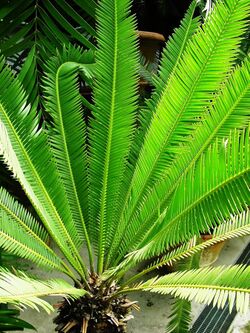Biology:Dioon purpusii
| Dioon purpusii | |
|---|---|

| |
| D. purpusii at the Florentine "Garden of Simples", Italy. | |
| Scientific classification | |
| Kingdom: | Plantae |
| Clade: | Tracheophytes |
| Clade: | Gymnospermae |
| Division: | Cycadophyta |
| Class: | Cycadopsida |
| Order: | Cycadales |
| Family: | Zamiaceae |
| Genus: | Dioon |
| Species: | D. purpusii
|
| Binomial name | |
| Dioon purpusii | |
Dioon purpusii (Purpus' cycad)[2] is a cycad tree endemic to a very small region in Mexico (Oaxaca, Puebla). It is found in Tomellín Canyon and the eastern branches of La Cañada de Cuicatlán.[3]
Name
The epithet purpusii, chosen by Joseph Nelson Rose, is an homage to one of Rose's contemporaries, colleague Carl Albert Purpus (1851–1941) (cf. Echeveria setosa Rose & Purpus).[4]
Description
Dioon purpusii grows about 5 meters high or taller, with a dbh about 40 cm being typical.[5]
The leaves of D. purpusii look like long (80 to 160 cm.) feathers sprouting from the top of the trunk at odd angles. They are compound, and can be flat or keel-shaped, and are a dark, lusterless gray-green. Each leaf is composed of a rachis with between 150 and 260 narrow (about 7–12 cm. long, 8–10 mm. wide), inserted leaflets attached. The leaflets are arranged along the somewhat flattened rachis in matching symmetrical pairs without alteration. They do not grow perfectly perpendicular to their rachis, but point up and away from the petiole, all at approximately the same angle (this can be 120 degrees, 180 degrees, or any angle in between). The first five to twenty centimeters (depending on the overall length of the leaf) are fully formed leaflets, which are straightly lanceolate with flat, dentate margins; those growing towards and at the end of the rachis reduce to mere spines.[5]
Seeing the difference between male and female cones is not difficult with D. purpusii. The seed cones (female) are large (35–45 cm.; 15–20 cm. diam.), pale brown and ovoid and contain similarly shaped seeds (3–4 cm. x 2.5–3.5 cm.) with cream-colored or white sarcotestas. The green or pallidly brown pollen cones (male) are long (20–30 cm.), narrow (7 or 8 cm. diam.), and also ovoid.[5]
Distribution
The species is endemic to the Mexican state of Oaxaca, where it occurs in Tomellin Canyon near the villages of Santa Catarina and Tomellin and in the Sierra Mixteca. The locations are in dry, tropical deciduous forest, mostly in the shade of trees. Mostly they grow on the steep rocky slopes of deep gorges together with cacti, agaves and Beaucarnea in 1000 to 1500 meters sea level. The annual precipitation amounts to 500 to 1000 mm and falls predominantly in the summer. Temperatures range from 20 to 30 °C in summer and 10 to 20 °C in winter.
In this area, it occurs in colonies rich in individuals that are scattered throughout the area. The area is relatively inaccessible. Sites and plants are hardly disturbed, the local population uses the leaves only on Palm Sunday.
Pests
Infestations of Aulacaspis yasumatsui, otherwise known as cycad aulacaspis scale, have been known to affect D. purpusii.[2]
Conservation status
The International Union for Conservation of Nature and Natural Resources has assessed its status (2003) as "Vulnerable", with numbers trending downwards.[1]
References
- ↑ 1.0 1.1 Assessor: Donaldson,J.S.; Evaluators: Vovides,A. & Chemnick,J. (Cycad Red List Authority) (2003). "Dioon purpusii in IUCN 2010". IUCN Red List of Threatened Species. Version 2010.1. International Union for Conservation of Nature and Natural Resources. http://www.iucnredlist.org/apps/redlist/details/42147/0. Retrieved May 1, 2010.
- ↑ 2.0 2.1 . Compiled by Susan E. Halbert, Ph.D."DPI-FDACS; Entomology Section". Tri-Ology (Reissued through the Florida Department of Agriculture and Consumer Services) 37 (4). July–August 1998. http://www.doacs.state.fl.us/pi/enpp/triology/archive/98-jul-aug.htm.. Retrieved May 1, 2010.[yes|permanent dead link|dead link}}]
- ↑ A new species in the genus Dioon (Zamiaceae) from north‐central Oaxaca, Mexico
- ↑ Paul C. Standley (1920). "Trees and Shrubs of Mexico". Smithsonian Institution, Washington D.C.: U.S. National Herbarium. https://archive.org/stream/treesshrubsofmex01stan#page/48/mode/2up. Retrieved May 2, 2010.
- ↑ 5.0 5.1 5.2 Cite error: Invalid
<ref>tag; no text was provided for refs namedkh
External links
| Wikimedia Commons has media related to Dioon purpusii. |
Wikidata ☰ Q150969 entry
 |


